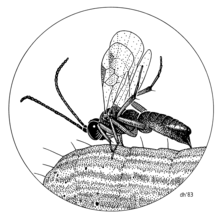Cotesia
Cotesia is a genus of braconid wasps first described by Peter Cameron in 1891. Some species parasitize caterpillars of species considered as pests. Thus they are used as biocontrol agents. Cotesia congregata parasitizes the tomato and the tobacco hornworms. C. glomerata and C. rubecula feed on the cabbage white and other white butterfly caterpillars. C. gonopterygis and C. risilis are host-specific and parasitize the common brimstone.[1]
| Cotesia | |
|---|---|
| Male C. congregata courting an immobilized female (slow motion) | |
| Male C. congregata courtship song | |
| Scientific classification | |
| Kingdom: | Animalia |
| Phylum: | Arthropoda |
| Class: | Insecta |
| Order: | Hymenoptera |
| Family: | Braconidae |
| Subfamily: | Microgastrinae |
| Genus: | Cotesia Cameron, 1891 |
| Diversity | |
| more than 300 species | |
The wasp C. melanoscelus parasitizes the caterpillar of the gypsy moth. It, and the gypsy moth, are native to Europe. The gypsy moth is an invasive species in North America, and C. melanoscelus has been imported as a biocontrol of the moth.[2]
Species
 Cotesia ruficrus illustrated by Des Helmore
Cotesia ruficrus illustrated by Des Helmore- Cotesia sp. cocoons
 Cotesia sp. cocoons
Cotesia sp. cocoons
See also
References
- Lozan, Aurel; Spitzer, Karel; Jaroš, Josef (2012-06-01). "Isolated peat bog habitats and their food connections: parasitoids (Hymenoptera: Ichneumonoidea) and their lepidopteran hosts". Journal of Insect Conservation. 16 (3): 391–397. ISSN 1366-638X. doi:10.1007/s10841-011-9425-4.
- McCullough, Deborah; Raffa, Kenneth; Williamson, R. Chris. "Natural Enemies of Gypsy Moth: The Good Guys!" (PDF). Entomology University of Wisconsin. Michigan State University Extension. Archived from Manuals/McCullough.Raffa.Williamson.GypsyMothGoodGuys.pdf the original Check
|url=value (help) (PDF) on 17 June 2010. Retrieved 18 April 2019.
External links
- Preliminary evolutionary relationships within the parasitoid wasp genus Cotesia
- Moisset, Beatriz (February 18, 2017). "Genus Cotesia". BugGuide. Retrieved January 4, 2019.
- Hymenoptera Institute. U. Kentucky
This article is issued from Wikipedia. The text is licensed under Creative Commons - Attribution - Sharealike. Additional terms may apply for the media files.